James Maliszewski's Blog, page 69
August 17, 2023
Blame Canada
 One of the fundamental characteristics of youth is ignorance. I say that not as a criticism but simply as a statement of fact. Young people, simply virtue of being young, lack knowledge, experience, and the wisdom that (hopefully) comes with them (though, to be fair, older people have only a marginally better track record on the wisdom front).
One of the fundamental characteristics of youth is ignorance. I say that not as a criticism but simply as a statement of fact. Young people, simply virtue of being young, lack knowledge, experience, and the wisdom that (hopefully) comes with them (though, to be fair, older people have only a marginally better track record on the wisdom front). This was certainly true of me as a kid. My own attempts at making sense of the world of my childhood were frequently thwarted by a combination of naivety and ignorance, not to mention my sheltered suburban upbringing. Consequently, there were a lot of events going on around me that I didn't understand or didn't understand fully.
A supreme of this is the moral panic known today as the "Satanic Panic." If you search through the more than 4000 posts on this blog, you'll find very few dedicated to the discussion of this topic, despite the fact that, for many roleplayers of my age or slightly younger, the Satanic Panic occurred smack dab in the middle of their introduction to the hobby. The lack of posts here on the topic is because, while I was certainly aware that some people somewhere believed that Dungeons & Dragons was diabolical, it was not a belief I encountered in my own life – quite the opposite, in fact.
With four decades of hindsight, it all seems very silly, but that's the nature of moral panics, whether they be about rock music, comic books, switchblades, or, as in this case, Dungeons & Dragons. To the extent that I had any thoughts about the Satanic Panic, I assumed that it must originated in the American South among those people, because who else would believe something so patently absurd? As I said, the young are ignorant, their understanding of the world sometimes skewed based on the prejudices of their elders.
Because the Satanic Panic always seemed so far away from me and my friends, I never really understood its actual origins – that is, until recently. The other day, I was reading something online and came across a startling (to me) fact: the proximate cause of the Panic was a 1980 book, published not in the United States but in Canada. The book, entitled Michelle Remembers, supposedly recounted the therapy of a woman called Michelle Smith under the guidance of psychiatrist Lawrence Pazder in Victoria, British Columbia. During these sessions, Smith "remembered" her abuse as a child at the hands of a Satanic cult that included her own mother among its members.
I say that Smith "remembered," because what Smith claimed to recall were the fruits of recovered-memory therapy, an extremely dubious form of psychotherapy that involves, among other things, hypnosis and the use of barbiturates to "recover" memories of past events supposedly so traumatic that the conscious mind suppresses them. To call recovered-memory therapy a pseudoscience is probably generous, but, at the time the book was published, it was relatively unknown and thus treated seriously by the credulous media outlets that helped spread Smith's absurd accusations.
And spread it they did. Though published in Canada, Michelle Remembers gained a lot of publicity through the popular American periodical People, not to mention that trusted purveyor of truth, the National Enquirer. Smith's story circulated widely and soon inspired others to come forward with their own concocted tales of abuse at the hands of Satanists. As so often happens in circumstances like this, the panic metastasized, its adherents purporting to find evidence of the fingerprints of hidden devil-worshippers on just about anything they didn't like, including Dungeons & Dragons.
I had never heard of Michelle Remembers. By the time I really became aware of the Satanic Panic, the book itself had long since been supplanted by other, even more lurid – but just as fabricated – claims about the demonic infiltration of Middle America. I do remember the 60 Minutes hit piece from 1985, but that had little to do with the book that released this ridiculous thought disease into the English-speaking world (I don't think the Satanic Panic had held much water elsewhere in the world, but I leave it to my readers to correct me). If I thought I'd learn anything useful from it, I might try to find a copy and read it, if only to come to a better understanding of something from my childhood whose origins I never really understood. Sadly, I doubt I'd gain much from the effort.
 This is, of course, a joke. Everyone knows I love maple syrup.
This is, of course, a joke. Everyone knows I love maple syrup.
August 15, 2023
Cozy Maps
 Here's the thing: I am preparing a regional map for my sha-Arthan setting and I must confess that I am having some difficulty in settling on a scale. I know that fans of OD&D favor the five – or six – mile hex for reasons both historical and rational. My natural inclination, as a traditionalist, is to choose one of those scales for the map, but I worry that scale might be too small for my purposes.
Here's the thing: I am preparing a regional map for my sha-Arthan setting and I must confess that I am having some difficulty in settling on a scale. I know that fans of OD&D favor the five – or six – mile hex for reasons both historical and rational. My natural inclination, as a traditionalist, is to choose one of those scales for the map, but I worry that scale might be too small for my purposes. This is, as I said, a regional map, depicting the territory of the Empire of Inba Iro and its neighbors. This is the area through which I want to introduce the overall setting, where a new campaign of Secrets of sha-Arthan might begin. Even though it's only a portion of a much larger world, I want it to be large enough to sprinkle with lots of adventure locales and scenario seeds. At the same time, I want its size to be both manageable for the referee and comprehensible to the players. In my opinion, too many creators of fantasy worlds think Bigger is Better and draw their maps accordingly. My intention is something that's, if not exactly small, a bit more "human-sized," if that makes sense.
I've always been very fond of this map from Chaosium's RuneQuest, which depicts the lands of Prax:
 While the map isn't perfect by any means, it comes very close to balancing manageability and comprehensibility. The area covered by the map is large enough to encompass lots of important landmarks/adventure sites and leave lots of space for the referee to place his own locales. Conversely, the map is also small enough that it isn't filled with lots of blank, empty spaces that take weeks for the characters to traverse. This kind of map feels "cozy," for lack of a better word and it's more or less what I'm aiming for with the first regional map of sha-Arthan, though I'm still wrestling with the specifics.
While the map isn't perfect by any means, it comes very close to balancing manageability and comprehensibility. The area covered by the map is large enough to encompass lots of important landmarks/adventure sites and leave lots of space for the referee to place his own locales. Conversely, the map is also small enough that it isn't filled with lots of blank, empty spaces that take weeks for the characters to traverse. This kind of map feels "cozy," for lack of a better word and it's more or less what I'm aiming for with the first regional map of sha-Arthan, though I'm still wrestling with the specifics.Do you have a favorite regional, "adventure scale" map for use with RPGs? I'm very curious to know which ones you like, because they might be helpful to me as I wrestle with making my own.
Polyhedron: Issue #5
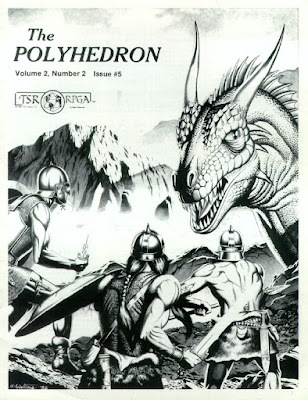 Issue #5 of Polyhedron (April 1982) features a cover illustration by Bob Walters, an artist who is otherwise unknown to me. It's a very nice piece, depicting what appears to be a trio of Viking-esque warriors facing off against a dragon. Given how good it is, I can't help but wonder why we never saw more artwork from Walters in Polyhedron or elsewhere in the RPG hobby.
Issue #5 of Polyhedron (April 1982) features a cover illustration by Bob Walters, an artist who is otherwise unknown to me. It's a very nice piece, depicting what appears to be a trio of Viking-esque warriors facing off against a dragon. Given how good it is, I can't help but wonder why we never saw more artwork from Walters in Polyhedron or elsewhere in the RPG hobby.The issue marks the appointment of Mary Kirchoff as editor of Polyhedron, while Frank Mentzer assumes the position of editor-in-chief. This suggests to me that both the RPGA and, by extension, Polyhedron were experiencing considerable growth during this time, or at least enough growth to warrant the expansion of its staff. Certainly, the hobby itself was still growing in 1982, thanks in no small part to the success of TSR in attracting younger players. Of course, not everyone was pleased by this growth, as evidence by a letter in this issue bemoaning the "munchkins with delusions of grandeur" who now "make up the overwhelming majority of new recruits to FRPing."
The second part of a three-part interview with Gary "Jake" Jaquet appears in this issue. As with the first part in the previous issue, it's filled with fascinating bits of information about TSR and the hobby at the time. Most interesting to me is Jaquet's defense of the "lukewarm" reviews that the Fiend Folio received in the pages of Dragon. "We call 'em like we see 'em," he explains, adding "It's not the best product it could have been." Jaquet then goes on to suggest that he feels Dragon, as a magazine for the entire hobby – compared to, say, more narrowly conceived periodicals like The Sorcerer's Apprentice – it needs to be fundamentally honest and not "self-serving," hence the critical reviews even of TSR products. He has a lot more to say on this topic and his philosophy of editing Dragon. If I can find the time, I will try to highlight some of his other comments in separate posts, because I think they're worth revisiting.
"Notes from the Dungeon Master" includes more tricks and traps for the DM. Most of those in this issue seem to involve mimics for some reason, but, to be fair, that is the purpose of a monster like that. Philip Meyers offers his impressions of a RPGA tournament in "The Round Table." Never having participated in one of them myself, I find his thoughts intriguing, because it sheds a little light on a part of the hobby that's long been somewhat opaque to me. Meyers offers both praise and criticism and Mentzer, in a separate article ("Counterpoint: As Fast as We Can ...") responds to both. Again, I get the impression from reading articles like these that the RPGA was growing quite quickly at the time, well beyond the capacity of its staff to keep up, hence the criticisms Meyers presents.
"Dispel Confusion" provides answers to some questions about the AD&D rules. One question revealed something that I apparently never understood. In AD&D, dragon breath damage is equal to the dragon's original hit point total, not his current total. I had always assumed the latter, perhaps influenced by the text in the Moldvay Basic Rules, but this is apparently wrong with regards to AD&D. Who says you can't learn anything new from a 40 year-old magazine? "Bag of Tricks" is an uncredited assortment of ideas for use with D&D and AD&D, like the suggestion that characters should take doors off their hinges to ease their escape later or making use of mules to carry extra treasure – all fairly banal stuff, though I suppose they might not be obvious to everyone.
"Spelling Bee" simply reprints the spells crystalbrittle and energy drain from Against the Giants, while Mike Brunton's "Figure Painting" offers lots of tips on miniatures painting. Sadly, there are still no photos or illustrations to accompany the latter article, which is a pity. For someone like myself, the photos of beautifully painted minis are the main attraction of articles such as this one. "Codebook" presents three encoded messages for readers to decipher, along with advice on how to crack simple codes. I find that fascinating, because I remember well the seeming ubiquity of codes and ciphers in the D&D games of my youth. I can't say I've seen them much in recent years and wonder why that might be.
The issue closes with more news about upcoming conventions, Roger Raupp's "Nor" comic, and some very cursory news on Top Secret, Boot Hill, and Gamma World. Disappointingly, "Nor" moves slowly and the mystery of the spacecraft that crash-landed on the fantasy world of the comic last issue receives little coverage in this one. With luck, that will change in coming issues, because I think it opens up lots of possibilities for fun adventures. Of course, as I noted before, I don't believe "Nor" lasts very long in the pages of Polyhedron, so the whole matter may be rendered moot anyway. Oh well.
August 11, 2023
Into the Woods
 As I mentioned, I was recently traveling about two and a half hours north of my home, in that part of Ontario urbanites call "cottage country" – not quite a truly rural area but close enough for cosseted city-dwellers looking to "rough it" for a little while. Being a cosseted city-dweller myself, that suits me just fine, though, after even a brief time in rustic surroundings of any sort, my thoughts inevitably turn to fantasy.
As I mentioned, I was recently traveling about two and a half hours north of my home, in that part of Ontario urbanites call "cottage country" – not quite a truly rural area but close enough for cosseted city-dwellers looking to "rough it" for a little while. Being a cosseted city-dweller myself, that suits me just fine, though, after even a brief time in rustic surroundings of any sort, my thoughts inevitably turn to fantasy. As with mushrooms – which I saw in large quantities during my arcadian sojourn – my imagination strongly associates woodlands of any kind with the fantastic. I suspect this is a side effect of my early reading of fairy tales and other myths and legends, many of which feature enchanted, haunted, or otherwise magical forests. Consequently, I frequently found myself pondering what it must be like for the typical D&D adventuring party as they trudged through the woods, never knowing just what they might find there.
 What I found, in addition to the aforementioned mushrooms, was a lot of insect life, especially moths. I was quite surprised by how many moths I saw fluttering beneath the shadowy canopy of the wood where I took a hike one day. I expected to see plenty of spiders, a prospect that filled me with some trepidation, and, while I did see more than a few, they were not nearly as plentiful as I feared. There were also, unfortunately, plenty of flies, gnats, and mosquitoes, as my itch-ravaged body can attest.
What I found, in addition to the aforementioned mushrooms, was a lot of insect life, especially moths. I was quite surprised by how many moths I saw fluttering beneath the shadowy canopy of the wood where I took a hike one day. I expected to see plenty of spiders, a prospect that filled me with some trepidation, and, while I did see more than a few, they were not nearly as plentiful as I feared. There were also, unfortunately, plenty of flies, gnats, and mosquitoes, as my itch-ravaged body can attest.Another thing that struck me was just how dark the woods could become, even during daylight hours. The trees where I was hiking were quite tall and possessed large, leafy branches that obscured the sun more than I had anticipated. I could still see quite well, of course, but it was still far less bright than I would have expected, given conditions outside the forest. Combined with the silence of the place, save for the sounds of a few birds, the overall effect was genuinely eerie at times.
 Wild berries – raspberries and blueberries mostly – abounded and that got me to thinking about foraging and other survival techniques in D&D and other roleplaying games, the sorts of stuff that has long fascinated me. In principle, I like the idea of delving into the nitty gritty of breaking camp, finding food, and dealing with environmental and other similar hazards. In practice, I tend to lose interest quite quickly and hand-wave a lot of these details, however compelling they seem in my head.
Wild berries – raspberries and blueberries mostly – abounded and that got me to thinking about foraging and other survival techniques in D&D and other roleplaying games, the sorts of stuff that has long fascinated me. In principle, I like the idea of delving into the nitty gritty of breaking camp, finding food, and dealing with environmental and other similar hazards. In practice, I tend to lose interest quite quickly and hand-wave a lot of these details, however compelling they seem in my head. I'm not entirely sure if that's a function of my own temperament or a reflection of the fact that I've never come across rules that simulate what I want without becoming bogged down in minutiae. Mind you, my hike was following an already-beaten trail, with little signposts and landmarks every so often, and I still managed to lose my way, so it seems plausible I'm too much of city boy to ever fully enter into the right frame of mind to understand and appreciate the wild places of the earth – but I very much want to.
Even after coming home, I still do.

August 8, 2023
Never Far from the OSR
I was away in northern Ontario last week. While there, I was surprised to discover that the main street of the closest small town included a game store. Though the focus of the place was clearly on board and card games, there was nevertheless a decent selection of other offerings, including roleplaying games. Most of the RPGs were the usual suspects – D&D, Pathfinder, etc. – but also present were multiple copies of Lamentations of the Flame Princess, which, along with some Goodman Games Dungeon Crawl Classics material, carried the banner for the OSR. Not bad!

Gamma World vs Traveller
I've been meaning to write a few posts about the more interesting TSR historical tidbits I've gleaned from Polyhedron's interview series. While re-reading the interview of James M. Ward from issue #3, I came across this:
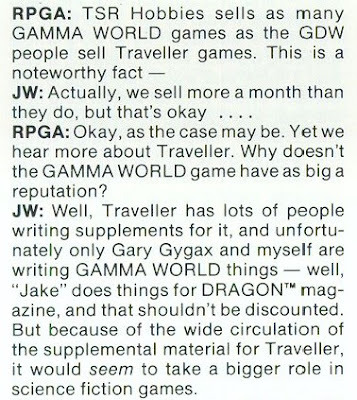 Since this interview came out in late 1981, I assume that Ward's claim about the relative sales figures of the Gamma World and Traveller is based on then-current information. While we don't, so far as I know, have any hard data on TSR's sales of Gamma World, we do know a lot about GDW's sales of Traveller. In 1981, the period about which I assume Ward is talking, GDW sold just shy of 60,000 copies of Traveller for the entire year, or roughly 5000 copies a month. If Ward's assertion above is accurate, Gamma World was doing better than that, though there's no way to know how much better.
Since this interview came out in late 1981, I assume that Ward's claim about the relative sales figures of the Gamma World and Traveller is based on then-current information. While we don't, so far as I know, have any hard data on TSR's sales of Gamma World, we do know a lot about GDW's sales of Traveller. In 1981, the period about which I assume Ward is talking, GDW sold just shy of 60,000 copies of Traveller for the entire year, or roughly 5000 copies a month. If Ward's assertion above is accurate, Gamma World was doing better than that, though there's no way to know how much better.Interestingly, Ward later notes, somewhat enviously, that Traveller "has lots of people writing supplements for it," which he implies is the reason for its being more well known. He may be on to something, because, if you look at GDW's sales of its support products for Traveller, they're quite impressive. In 1981 alone, GDW sold 81,159 copies of supplements, like The Spinward Marches and 50,865 copies of adventures, like The Kinunir. Taken together, that's more than twice the number of copies of rulesets sold during the same period (and I'm not including the sales of rules expansion books like Mercenary or double adventures).
Ward seems to be aware of the fact that the lack of support for Gamma World – something I regularly note when I talk about the game – had an adverse effect on its popularity relative to other science fiction RPGs of the time. He adds that "only Gary Gygax and myself are writing GAMMA WORLD things," which suggests to me that TSR never had any kind of plan for supporting the game beyond whatever Gygax and others might produce on their own. Of course, I'm left wondering what became of these Gamma World supplements or adventures Ward was supposedly working, because, so far as I know, none of them ever came to publication.
Without verifiable figures, it's impossible to judge the veracity of the claim that Gamma World outsold Traveller on a monthly basis. I certainly think it's plausible, given the popularity of Dungeons & Dragons at the time and the reach of TSR within the hobby. If Ward is indeed correct, then it represents an incredible misstep on the part of TSR that Gamma World was not better supported, because it would have given them another significant source of revenue at the height of the early '80s RPG fad – but then no one has ever claimed that TSR was the most well run of companies at any point in its existence ...
Into the Megadungeon: Mysteries
August 7, 2023
Polyhedron: Issue #4
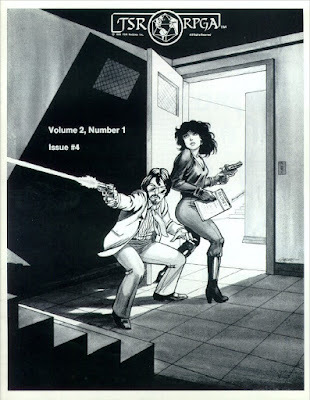 Issue #4 of Polyhedron (March 1982) is the first issue to officially bear that title, though it's nowhere to be seen on its cover, which features original artwork by Larry Elmore. The first use of the new title appears is inside, where it's also given the definite article – The Polyhedron. Frank Mentzer explains that the title was suggested by RPGA member Bill Huber of Petaluma, California, beating out many other suggestions (e.g. Role Players Guide to Adventure, Multiverse, Roles & Rules, etc.), none of which struck me as very good.
Issue #4 of Polyhedron (March 1982) is the first issue to officially bear that title, though it's nowhere to be seen on its cover, which features original artwork by Larry Elmore. The first use of the new title appears is inside, where it's also given the definite article – The Polyhedron. Frank Mentzer explains that the title was suggested by RPGA member Bill Huber of Petaluma, California, beating out many other suggestions (e.g. Role Players Guide to Adventure, Multiverse, Roles & Rules, etc.), none of which struck me as very good. Highlighted on the Letters page is a missive from Gary Gygax, in which he talks about his first meeting with James M. Ward. Mentzer follows this with the following comment: "See, folks, he really reads this stuff!" While I'm sure it was meant innocently enough, the comment strikes me as an example of the Cult of Gygax that TSR promoted sometimes promoted and to which fanboys like myself were often prone. With the benefit of hindsight, it also reminds me uncomfortably of the parasocial relationships with celebrities that contemporary social media tries to foster.
Mentzer's "Where I'm Coming From" is brief and focuses on new and upcoming features in Polyhedron, such as Jon Pickens's column for Basic D&D and Roger Raupp's "Nor" comic strip, both of which premier in this issue. There's a similarly brief piece announcing the winner of Grenadier's 1980–81 "Wizard's Gold" giveaway. The winner was a 14 year-old boy from Florida, which oddly pleased me. I remember the ads for "Wizard's Gold" in the pages of Dragon at the time but I can't say I ever gave much thought to who might have won. More than four decades later, now I do.
"RPGA Interview with 'Jake' Jaquet" is, as its title suggests, an interview – and a lengthy one at that – Gary "Jake" Jaquet, one of the forgotten employees of TSR Hobbies during the late '70s and early '80s. His name is well known to me because of his involvement in the creation of the first edition of Gamma World. He was also an important figure in the early days of Dragon, where he served in a variety of capacities, including Publisher. As with previous interviews in Polyhedron, this one is full of wonderful anecdotes and trivia about TSR and its products. I could – and probably should – devote an entire post to sharing some of these tidbits. For now, though, I'll share one of them, which feels strangely relevant in our present age.
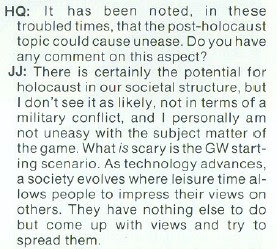 "White Rabbits" is where Frank Mentzer corrects errors and oversights from previous issues. This time, he takes the time to credit people whose names were inadvertently omitted. One of these names is Jeff Dee, whose illustration of the bone (not ice) devil was the subject of some speculation in an earlier post on this blog. Don Turnbull's "Turnbull Talking" serves as a reminiscence of his early experiences with D&D and the expansion of its roster of available character classes. Turnbull notes that some players and referees dislike the addition of new classes to the game, but he does not share this view.
"White Rabbits" is where Frank Mentzer corrects errors and oversights from previous issues. This time, he takes the time to credit people whose names were inadvertently omitted. One of these names is Jeff Dee, whose illustration of the bone (not ice) devil was the subject of some speculation in an earlier post on this blog. Don Turnbull's "Turnbull Talking" serves as a reminiscence of his early experiences with D&D and the expansion of its roster of available character classes. Turnbull notes that some players and referees dislike the addition of new classes to the game, but he does not share this view. "Spell Bee" returns, with a look at the AD&D versions of the spells magic missile, fireball, and lightning bolt – complete with diagrams! Believe it or not, this is actually a very interesting and useful article. Though the article isn't credited, internal evidence ("My wizard Felonius") suggests that Frank Mentzer wrote it. He does a good job, in my opinion, of laying out how these three common offensive spells actually work according to the rules of AD&D, something that's often forgotten by many players. Certainly, some might find it a bit tedious in its specificity, but we must remember that Mentzer cut his teeth in the world of official AD&D tournaments, so his knowledge of the game's rules is highly exact. I don't think the article can be criticized for being similarly precise.
"Dispel Confusion" answers some not very interesting AD&D questions, while "Basically Speaking" by Jon Pickens is a disappointingly dull overview of what to do with your shiny new copy of the D&D Basic Set, right down to how to use that crayon that came in the box. "News from HQ" is just a collection of ephemeral notes about then-current concerns of the RPGA. Roger Raupp's "Nor" is a full-page comic whose first installment shows a spaceship crash land on a planet that appears to be a fantasy setting of some sort. This is a common enough trope, but I'm curious to see where Raupp takes it. On the other hand, I started reading Polyhedron with issue #8 and don't recall seeing "Nor." That suggests the comic, like Tom Wham's "Rocksnaz" from issues #1 and #2 won't last long ...
I continue to find Polyhedron interesting reading, though mostly from a historical perspective. More so than, say, Dragon, the RPGA newsletter includes lots of "inside baseball" information about TSR and its employees that I find very compelling. That's probably while I'll make a serious attempt to examine its interview articles much more closely in the coming weeks. There are lots of nuggets to mine in them and I suspect that readers of this blog will find them as fascinating as I do.
August 2, 2023
Retrospective: Quagmire!
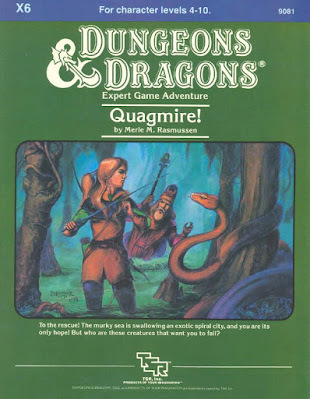 Like
The Forest Oracle
, Quagmire! is an almost universally disliked module from the early Silver Age of Dungeons & Dragons – and justifiably so in my opinion. By almost any standard I can think of, this is not a good module and I find it difficult to muster anything more than the feeblest defense of it. Nevertheless, for all its manifest flaws, I have a strange fondness for it. Therefore, it is not the intention of this post to change anyone's opinion of Quagmire!, but rather to explain the sources of my weird affection for it.
Like
The Forest Oracle
, Quagmire! is an almost universally disliked module from the early Silver Age of Dungeons & Dragons – and justifiably so in my opinion. By almost any standard I can think of, this is not a good module and I find it difficult to muster anything more than the feeblest defense of it. Nevertheless, for all its manifest flaws, I have a strange fondness for it. Therefore, it is not the intention of this post to change anyone's opinion of Quagmire!, but rather to explain the sources of my weird affection for it.Originally published in 1984 and written by Merle M. Rasmussen, best known as the designer of Top Secret, Quagmire! is designated module X6, indicating that it was intended to support the D&D Expert Set. This fact undoubtedly explains a small part of my affection for the module, since the Expert Set, too, occupies a special place in my heart. The module's premise is that the player characters, while near a seacoast, find a bottle inside of which is a plea written on a piece of parchment. The plea was written by someone who calls himself Molariah, King of the Swamp and Ruler of the city of Quagmire. The king explains that the city, once a center of trade and commerce, languishes under a triple threat of rising waters, plague, and a blockade by their covetous neighbors. He offers a rich reward to anyone who can aid him and his people within six months of his having written the plea, which is how long he reckons the city can hold out. Unfortunately, the plea is not dated, so there is no way of knowing whether it is already out of date by the time the PCs find it.
The characters can, of course, check around the local ports for rumors about Quagmire (who names their city such a thing?) and will find some evidence to support what the King of the Swamp wrote. The adventure then assumes they set out westward toward the Serpent Peninsula where the city supposedly lies in order to render what aid they can. Even by the standards of D&D modules from the time period, this is a flimsy basis for an adventure, but I like it all the same. A big part of it is that the module adds to the map of the "Known World" setting introduced in the The Isle of Dread and previously expanded in Master of the Desert Nomads. I'm a sucker for maps of any kind, but especially setting maps. Likewise, as I've noted before, I was intrigued by the "Known World," so its expansion here no doubt elevates it in my estimation.
The bulk of Quagmire! is simply a hexcrawl through "the Wild Lands" of the Serpent Peninsula and the surrounding area. Rasmussen directs the referee to the rules for wilderness travel and exploration in the Expert Set, but also provides more than two dozen unique random encounters to spice up the characters' trek through the region. This is in addition to a similar number of encounters tied to a specific location and six new monsters. I appreciate what Rasmussen is trying to do here, even if his reach somewhat exceeds his grasp. For example, many the unique encounters are rather dull, consisting of herds of mundane animals or even inclement weather. My guess is that they were meant to be evocative of the locale – a hot, humid, swampy peninsula – but the execution regularly falls flat.
The same must be said about the centerpiece of the whole module, the city of Quagmire. That's a shame, because the idea behind the city (and its two sister cities) is delightfully fantastical. Quagmire is housed within a giant spiraled seashell consisting of thirteen levels and nearly 60 keyed locations. However, the location is simply too small for its purpose. Quagmire is supposed to be an important trading port in the region, filled with riches and exotic goods, a place well known across the Known World. Instead, it comes across as a very tiny place that, even before its current travails, could not have housed more than a couple of hundred people at most. Now, it's even more pathetic, with only about 40 survivors left.
Yet, for all of that, there's a peculiar majesty to the place nonetheless – or at least it seemed so to me when I first read the module almost four decades ago. In my mind's eye, Quagmire is a much more impressive and indeed magical place, befitting a giant, inhabited seashell rising up out of the sand. Ultimately, I suspect that's why I retain a fondness for module X6: it inspired me. As written, there's no question that Quagmire! is underwhelming. However, I rarely use modules wholly as written, preferring to use them as starting points for my own imagination – a map here, an encounter there, etc., to which I added my own ideas to those provided by the designer.
Viewed from that perspective, Quagmire! is far from being in contention for the worst module ever published for Dungeons & Dragons. A better summation, I think, is that it fails to live up to its potential. All of the ingredients for a solid hexcrawl adventure are there, along with a central location that's perfect for pulp fantasy. For whatever reason – a failure to follow through, editorial meddling on the part of TSR – Rasmussen was unable to stick the landing. That leaves me wondering what might have been and whether the cool adventure I've had in my head since 1984 was ever really a possibility.
August 1, 2023
Original Polyhedron Art
As I noted in my post about issue #3 of Polyhedron, the newsletter contains a lot of original art by TSR's stable of artists. According to its credits page, here are the artists who contributed one or more pieces to the issue:
 Most of those names should be familiar to aficionados of early '80s TSR Hobbies. The other two that might not be familiar are Bell and J.F. Mentzer. Bell is Greg Bell, who did a lot of the illustrations in the little brown books of OD&D. J.F. Mentzer is not, as I initially thought, Frank Mentzer, whose full name is Jacob Franklin Mentzer III, but rather his father, Jacob Franklin Mentzer II, as we'll see shortly.
Most of those names should be familiar to aficionados of early '80s TSR Hobbies. The other two that might not be familiar are Bell and J.F. Mentzer. Bell is Greg Bell, who did a lot of the illustrations in the little brown books of OD&D. J.F. Mentzer is not, as I initially thought, Frank Mentzer, whose full name is Jacob Franklin Mentzer III, but rather his father, Jacob Franklin Mentzer II, as we'll see shortly.The first piece of artwork I'd like to share from the issue is a depiction of an ice devil by an unknown artist.
 Who's the illustrator? To me, it looks like it could be Dave LaForce, but I am uncertain of that attribution.
Who's the illustrator? To me, it looks like it could be Dave LaForce, but I am uncertain of that attribution.Next up is this excellent Lich by Darlene:
 Darlene also contributed this portrait of a wizard that I rather like.
Darlene also contributed this portrait of a wizard that I rather like.
 This party of adventurers is definitely the work of Dave LaForce. His signature is clearly visible on the righthand side of the piece, along the magic-user's staff.
This party of adventurers is definitely the work of Dave LaForce. His signature is clearly visible on the righthand side of the piece, along the magic-user's staff.
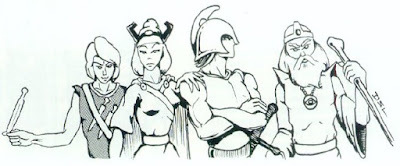 Here's the piece attributed to JFM II, as you can see in the bottom lefthand side of the illustration. I'm not entirely sure what it's meant to depict, though it calls to mind the fairytale of the Frog Prince. In any case, I rather like it, if only because its style is so clearly different from that of the other artwork found in the issue.
Here's the piece attributed to JFM II, as you can see in the bottom lefthand side of the illustration. I'm not entirely sure what it's meant to depict, though it calls to mind the fairytale of the Frog Prince. In any case, I rather like it, if only because its style is so clearly different from that of the other artwork found in the issue.
 And finally there's another Gamma World piece by Erol Otus:
And finally there's another Gamma World piece by Erol Otus:
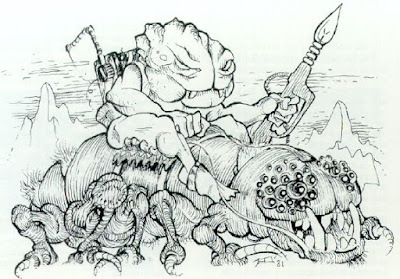 These are less than half the original illustrations appearing in the issue, but they're the ones that stood out as being especially worth of comment. Should there be interest, I may post more examples of this artwork in the weeks to come. For now, I thought it sufficed to draw your attention to these, all of which caught my eye as I was reading.
These are less than half the original illustrations appearing in the issue, but they're the ones that stood out as being especially worth of comment. Should there be interest, I may post more examples of this artwork in the weeks to come. For now, I thought it sufficed to draw your attention to these, all of which caught my eye as I was reading.
James Maliszewski's Blog
- James Maliszewski's profile
- 3 followers



